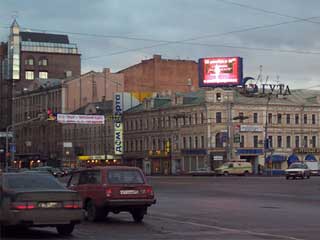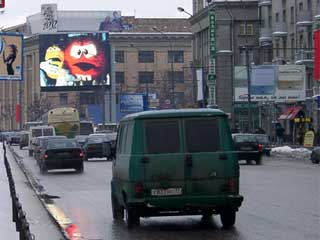Trends and developments in the “Outdoor Video and TV” informational and advertising systems
In the issue #4/2000 we promised to provide a full text of the report. Here it is. Report at the R&D Institute of Informational Technologies of the Moscow Government, for the National Committee for Economic Cooperation with Latin American Countries and Latin American Department of the Foreign Relations Ministry of Russia.
The recent decade has witnessed the explosive development of those technological areas directly or indirectly related with spreading information or advertising among large masses of people. Such areas include “traditional” TV, radio, newspapers and magazines, outdoor advertising as well as the newest trends such as the Internet and large outdoor electronic screens.
From all sides people are assaulted with information. The number of TV and radio channels and the number of printed mass media grows daily. The streets are filled with outdoor advertising billboards. The number of Internet sites and portals grows exponentially. Such variety breeds new and unexpected problems:
- Difficult choice. What shall I watch and listen to? What Internet site shall I visit? What news channel is better?
- Effectiveness of TV or radio advertising. With dozens of channels instantly available, people tend to switch to a different channel during the advertising block and stay with the new channel to watch what seems more interesting.
- Coverage of Internet-news and projects outside Internet.
Thus, an intensive search started for new technologies that would improve efficiency of political, informational, commercial, advertising, social and other media events and campaigns. “Outdoor Video and TV” based on large electronic screens turned to be one of such effective technologies.
The “Outdoor Video and TV” technology has to be considered together with a range of other factors:
- Limited number of “key” advertising sites suitable for large electronic screens in any city.
- Focused broadcasts: the viewing audience (passersby, drivers and passengers) are unable to switch off advertising and move to a different channel.
- Improved effectiveness of advertising: psychologists have long proved that the information stands better chances of being absorbed if it is visual and dynamic. Therefore, advertising on electronic screens is much more effective than traditional static billboards.
- Information and advertising on outdoor electronic screens is not perceived as an annoying factor by the majority of viewers. It does not interrupt an interesting program or feature film and, in fact, helps to fill in the “lost” time spent in a traffic jam or waiting in the street.
- Better coverage of the audience: during various mass events such as advertising campaigns, sports events, carnivals, concerts etc. images on large electronic screens can be seen from long distances, and those who cannot see the action on stage can witness it on large screens.
- Modern digital technology: large electronic screens can demonstrate video and computer-generated images. Thus, time for creating a commercial is shortened drastically. This is especially important for Internet-based advertising.
 |
 |
| Large outdoor advertising screens in Moscow | |
Gradually, large outdoor screen networks become the key element in government, regional and municipal informational infrastructure. Electronic screens are widely used as support equipment in various mass actions, advertising campaigns, carnivals, concerts and other events. The diagram below shows the growth in the number of large full-color outdoor video screens around the world.
 Growing dynamics of the number of outdoor electronic screens worldwide
Growing dynamics of the number of outdoor electronic screens worldwide(Note: Technologically, it became possible to produce full-color large outdoor systems based on modern lamps and LEDs only in 1995).
The diagram demonstrates that the number of large outdoor screens is growing fast. Separate screens are now merged into networks to drastically improve the efficiency of this advertising media.
Moreover, US and Russian engineers found ways to gradually reduce cost of large screen installations. Naturally, the screens are becoming more and more popular as their cost falls to become affordable and comparable to traditional neon signs.
Unfortunately, most manufacturers closed all technological processes related to large screens production that places customers in technological dependence. This results in technical difficulties in maintenance and service of screens and does not help in stimulating indigenous manufacturers.
However, some new approaches have been identified. For example, in Russia a new approach that opens some latest technological advances and offers the possibility of manufacturing large outdoor screens locally, similar to the PC assembly plants has been developed. This is a very positive development that represents a step forward in making this technology available for everyone.
The following priority developments in the market of large electronic advertising screens can be identified:
- Construction of informational advertising networks within a city, within one country or in several countries (similar to CNN structure) based on our patented technology of large “Outdoor Video and TV” systems.
- Development, upgrading and maintenance of these digital outdoor networks using the local assembly and manufacturing facilities within the interested countries.
New trends in the development of “Outdoor Video and TV” technology
A comprehensive analysis of the market of electronic screens revealed the following that large outdoor electronic screens have common shortcomings irrespective of manufacturer:
- Poor software and control system that prevents flexible control of the outdoor screen in real time.
- Closed assembly and manufacturing technology.
- Incompatibility with Internet-based technologies.
Over the last several years, research and experimental studies have been conducted throughout the world to develop modern technological solutions to manufacturing and assembly of large outdoor screens.
The companies that would be capable of resolving the following problems will become leaders in this newest technological field:
- Significantly cut down assembly expenses and expenses for installation of “Outdoor TV” systems.
- Reduce technical maintenance costs (especially, compared to other manufacturers).
At present the following information is available:
- Monitor and control screens via Internet (few companies have so far developed such capabilities);
- Upgrade of large outdoor screens to increase their service life;
- Develop adjustable brightness control (in case of direct sunlight) and operate 24/7 mode at temperature range of -60°C to +60°C.
Examples of applications of “Outdoor Video and TV” systems
Modern “Outdoor Video and TV” systems are a new mass media carrier capable of:
- Broadcasting real time video signals, including TV programs and TV advertising.
- Allocating advertising spots in a flexible mode and changing advertising programs depending on specific requirements and changing conditions (changing and substituting commercials, providing individual broadcasting schedule).
- Being installed in a stationary mode (in the streets, on house roofs, on house walls) and in a mobile mode (on the spot assembly) that could be effectively used during political rallies, shows, concerts and sport events.
- Displaying advertising at the rates drastically cheaper that on TV and radio.
- Attracting attention of passersby without annoying them as often happens during TV programs.
- Operating in 24/7 mode with adjusting broadcasting depending on the prevailing conditions.
Large electronic outdoor screens bring viewers closer to the place of action, transfer images to places where traditional mass media is unable to reach the viewers.
Cost and Return-On-Investment (ROI) of “Outdoor Video and TV” systems
The cost of “Outdoor Video and TV” systems consists of the cost of the electronic screen and its assembly, adjusting the system, the construction and installation works (or procurement of the mobile base). The cost depends on the manufacturer and specific characteristics of the screen. The sizes of the outdoor electronic screen depend on the requirements and the distance to viewers and vary from 6x8 to 15x20 meters and more.
The commercial effect from using outdoor screens depends on the purpose of its operation and competent utilization of advertising time. The construction of networks of digital outdoor video systems and utilization of Internet-compatible technologies will make “Outdoor Video and TV” systems comparable to traditional TV in their commercial and informational aspects.
Conclusion
- The current tendency towards spreading large screen outdoor technology throughout the world.
- The marked improvements that the US, Russian and Japanese engineers introduced into these systems.
The future development of Internet-compatible “Outdoor Video and TV” systems based on large electronic screens and screen networks will become not only an important factor of political and social life but also a factor of significant commercial profits for its users.





